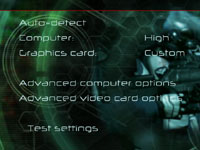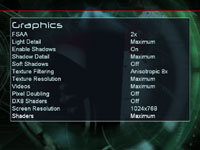R600: ATI Radeon HD 2900 XT
Written by Tim Smalley
May 16, 2007 | 05:39
Tags: #2900 #analysis #anisotropic #architecture #benchmarks #filtering #hd #image #performance #quality #r600 #radeon #review #technology #xt

F.E.A.R.
Publisher: VU GamesWe used the full retail version of F.E.A.R. patched to version 1.08. The game makes use of a lot of effects -- including soft shadows, volumetric lighting, parallax mapping and particle effects, along with a slow-motion mode that really taxes today's top of the line GPU's. There's extensive use of high resolution textures. The walls are both bump mapped and parallax mapped to give a realistic feel to the brick walls that are a big feature of this title. Also, the world is incredibly destructible, which is made more realistic by parallax mapping.
In general, this is a graphically intense game and the most outstanding part of the graphics engine is undoubtedly the player character's shadow that is cast on the wall. It also has the most advanced A.I. that we have ever seen in a game engine to date -- there are times when you'll find yourself with your pants down around your ankles with nowhere to go.
We used the built in benchmark for our testing. Although this isn't as stressful as many portions of the game, it does give a good indication of overall game performance.
F.E.A.R.
1600x1200 4xAA 16xAF, Maximum Quality
- Nvidia GeForce 8800 GTX 768MB SLI
- ATI Radeon HD 2900 XT 512MB CrossFire
- Nvidia GeForce 8800 Ultra 768MB
- Nvidia GeForce 8800 GTX 768MB
- BFGTech GeForce 8800 GTS OC 640MB SLI
- ATI Radeon X1950 XTX 512MB CrossFire
- BFGTech GeForce 8800 GTS OC 320MB SLI
- BFGTech GeForce 8800 GTS OC 640MB
- BFGTech GeForce 8800 GTS OC 320MB
- ATI Radeon HD 2900 XT 512MB
- ATI Radeon X1950 XTX 512MB
- Nvidia GeForce 7900 GTX 512MB
-
-
103.3
-
61.0
-
-
-
102.3
-
20.0
-
-
-
94.7
-
48.0
-
-
-
85.0
-
44.0
-
-
-
78.7
-
49.0
-
-
-
75.7
-
23.0
-
-
-
75.3
-
47.0
-
-
-
63.0
-
31.0
-
-
-
60.0
-
31.0
-
-
-
59.3
-
21.0
-
-
-
56.3
-
27.0
-
-
-
45.3
-
26.0
-
0
25
50
75
100
Frames Per Second
-
Average
-
Minimum
F.E.A.R.
1920x1200 4xAA 16xAF, Maximum Quality
- ATI Radeon HD 2900 XT 512MB CrossFire
- Nvidia GeForce 8800 GTX 768MB SLI
- Nvidia GeForce 8800 Ultra 768MB
- Nvidia GeForce 8800 GTX 768MB
- BFGTech GeForce 8800 GTS OC 640MB SLI
- BFGTech GeForce 8800 GTS OC 320MB SLI
- ATI Radeon X1950 XTX 512MB CrossFire
- BFGTech GeForce 8800 GTS OC 640MB
- BFGTech GeForce 8800 GTS OC 320MB
- ATI Radeon HD 2900 XT 512MB
- ATI Radeon X1950 XTX 512MB
- Nvidia GeForce 7900 GTX 512MB
-
-
90.7
-
20.0
-
-
-
88.3
-
54.0
-
-
-
79.7
-
48.0
-
-
-
71.0
-
36.0
-
-
-
67.3
-
41.0
-
-
-
66.3
-
40.0
-
-
-
65.0
-
18.0
-
-
-
54.0
-
28.0
-
-
-
52.0
-
28.0
-
-
-
51.0
-
18.0
-
-
-
48.0
-
22.0
-
-
-
39.0
-
22.0
-
0
25
50
75
100
Frames Per Second
-
Average
-
Minimum
F.E.A.R.
2560x1600 2xAA 16xAF, Maximum Quality
- Nvidia GeForce 8800 GTX 768MB SLI
- ATI Radeon HD 2900 XT 512MB CrossFire
- Nvidia GeForce 8800 Ultra 768MB
- Nvidia GeForce 8800 GTX 768MB
- BFGTech GeForce 8800 GTS OC 640MB SLI
- ATI Radeon X1950 XTX 512MB CrossFire
- BFGTech GeForce 8800 GTS OC 320MB SLI
- BFGTech GeForce 8800 GTS OC 640MB
- BFGTech GeForce 8800 GTS OC 320MB
- ATI Radeon HD 2900 XT 512MB
- ATI Radeon X1950 XTX 512MB
- Nvidia GeForce 7900 GTX 512MB
-
-
78.0
-
57.0
-
-
-
74.3
-
16.0
-
-
-
66.7
-
39.0
-
-
-
61.3
-
37.0
-
-
-
59.3
-
45.0
-
-
-
57.7
-
16.0
-
-
-
55.7
-
42.0
-
-
-
44.3
-
25.0
-
-
-
43.0
-
25.0
-
-
-
42.0
-
17.0
-
-
-
40.0
-
22.0
-
-
-
24.0
-
13.0
-
0
10
20
30
40
50
60
70
80
Frames Per Second
-
Average
-
Minimum
F.E.A.R.
2560x1600 4xAA 16xAF, Maximum Quality
- ATI Radeon HD 2900 XT 512MB CrossFire
- Nvidia GeForce 8800 GTX 768MB SLI
- Nvidia GeForce 8800 Ultra 768MB
- Nvidia GeForce 8800 GTX 768MB
- ATI Radeon X1950 XTX 512MB CrossFire
- BFGTech GeForce 8800 GTS OC 640MB SLI
- ATI Radeon HD 2900 XT 512MB
- BFGTech GeForce 8800 GTS OC 320MB SLI
- ATI Radeon X1950 XTX 512MB
- BFGTech GeForce 8800 GTS OC 640MB
- BFGTech GeForce 8800 GTS OC 320MB
- Nvidia GeForce 7900 GTX 512MB
-
-
56.3
-
10.0
-
-
-
52.3
-
39.0
-
-
-
45.0
-
28.0
-
-
-
40.0
-
22.0
-
-
-
38.0
-
10.0
-
-
-
37.0
-
26.0
-
-
-
32.0
-
10.0
-
-
-
30.7
-
9.0
-
-
-
29.0
-
14.0
-
-
-
27.3
-
14.0
-
-
-
22.7
-
11.0
-
-
-
14.0
-
5.0
-
0
10
20
30
40
50
60
Frames Per Second
-
Average
-
Minimum
F.E.A.R. performance with CrossFire enabled was very promising, but that's largely because Nvidia's cards just aren't scaling particularly well at the moment. Take the GeForce 8800 GTS 640MB for example; scaling at 2560x1600 4xAA 16xAF was only 37 percent. At 1600x1200 4xAA 16xAF, the performance improvement after adding a second card was down to 25 percent.
At resolutions where you're going to get a playable frame rate with a single card (1600x1200 and 1920x1200 with 4xAA), BFGTech's GeForce 8800 GTS 640MB is around six percent faster. At 2560x1600, we drop into the realms of unplayability (based on the fact that 50-60 fps in the game's built in performance test equates to 30-40 fps in the more intense sections of the game) but the Radeon HD 2900 XT comes out on top with 4xAA applied. Radeon HD 2900 XT CrossFire also tops the performance tables too, but there's definitely something wrong with Nvidia's performance scaling with SLI in this title.












Want to comment? Please log in.